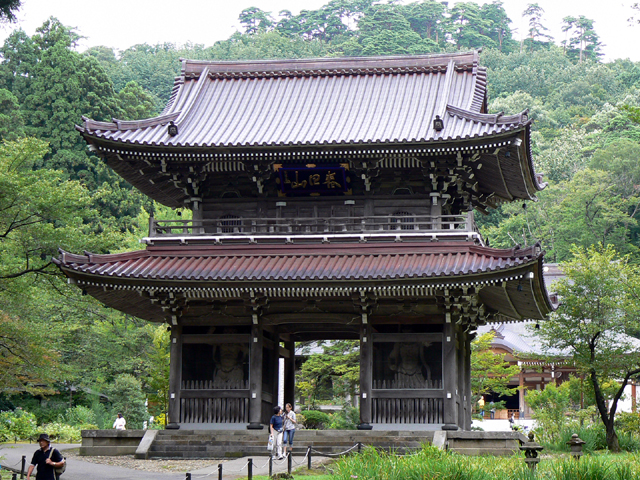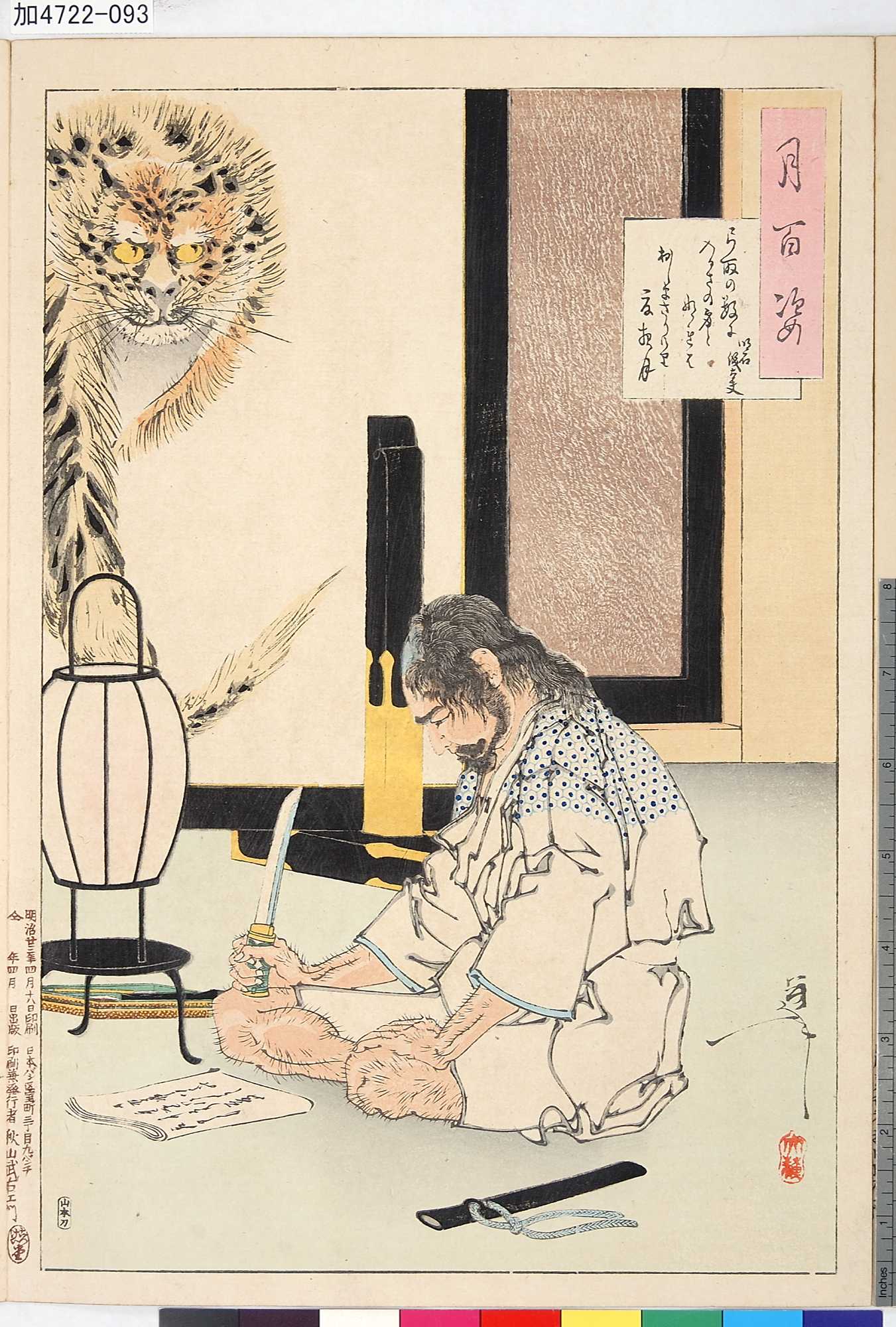|
Ryōkan Taigu
was a quiet and unconventional Sōtō Zen Buddhist monk who lived much of his life as a hermit. Ryōkan is remembered for his poetry and calligraphy, which present the essence of Zen life. Early life Ryōkan was born in the village of Izumozaki in Echigo Province (now Niigata Prefecture) in Japan to the village headman. He renounced the world at an early age to train at nearby Sōtō Zen temple Kōshō-ji, refusing to meet with or accept charity from his family. Once the Zen master Kokusen visited the temple, and Ryōkan was deeply impressed with his demeanour. He solicited permission to become Kokusen's disciple. Kokusen accepted, and the two returned to Entsū-ji monastery in Tamashima (now Okayama Prefecture). It was at Entsū-ji that Ryōkan attained satori and was presented with an Inka by Kokusen. Kokusen died the following year, and Ryōkan left Entsū-ji to embark on a long pilgrimage. He lived much of the rest of his monastic life as a hermit. His decision to l ... [...More Info...] [...Related Items...] OR: [Wikipedia] [Google] [Baidu] |
Niigata Prefecture
is a Prefectures of Japan, prefecture in the Chūbu region of Honshu of Japan. Niigata Prefecture has a population of 2,131,009 (1 July 2023) and is the List of Japanese prefectures by area, fifth-largest prefecture of Japan by geographic area at . Niigata Prefecture borders Toyama Prefecture and Nagano Prefecture to the southwest, Gunma Prefecture to the south, Fukushima Prefecture to the east, and Yamagata Prefecture to the northeast. Niigata, Niigata, Niigata is the capital and largest city of Niigata Prefecture, with other major cities including Nagaoka, Niigata, Nagaoka, Jōetsu, Niigata, Jōetsu, and Sanjō, Niigata, Sanjō. Niigata Prefecture contains the Niigata Major Metropolitan Area centered on Niigata with a population of 1,395,612, the largest metropolitan area on the Sea of Japan coast and the twelfth-largest in Japan. Niigata Prefecture is part of the historic Hokuriku region and features Sado Island, the sixth largest island of Japan in area following the List o ... [...More Info...] [...Related Items...] OR: [Wikipedia] [Google] [Baidu] |
Okayama Prefecture
is a Prefectures of Japan, prefecture of Japan located in the Chūgoku region of Honshu. Okayama Prefecture has a population of 1,826,059 (1 February 2025) and has a geographic area of 7,114 Square kilometre, km2 (2,746 sq mi). Okayama Prefecture borders Tottori Prefecture to the north, Hyōgo Prefecture to the east, and Hiroshima Prefecture to the west. Okayama is the capital and largest city of Okayama Prefecture, with other major cities including Kurashiki, Tsuyama, and Sōja. Okayama Prefecture's south is located on the Seto Inland Sea coast across from Kagawa Prefecture on the island of Shikoku, which are connected by the Great Seto Bridge, while the north is characterized by the Chūgoku Mountains. History Prior to the Meiji Restoration of 1868, the area of present-day Okayama Prefecture was divided between Bitchū Province, Bitchū, Bizen Province, Bizen and Mimasaka Province, Mimasaka Provinces. Okayama Prefecture was formed and named in 1871 as part of the large-scale ... [...More Info...] [...Related Items...] OR: [Wikipedia] [Google] [Baidu] |
Stephen Mitchell (translator)
Stephen Mitchell (born 1943) is a poet, translator, scholar, and anthologist. Born in Brooklyn, Mitchell is known for his translations and adaptions of works including the ''Tao Te Ching'', the Hebrew Bible's book of Psalms, the ''Epic of Gilgamesh'', works of Rainer Maria Rilke, and some Christian texts. Education Stephen Mitchell was born to a Jewish family, educated at Poly Prep, Amherst College, the University of Paris, and Yale University, and "de-educated" through intensive Zen practice. He studied for years with Zen master Seungsahn and for years with Robert Baker Aitken Rōshi. Career Mitchell's translations and adaptions include the ''Tao Te Ching'', which has sold over a million copies, ''Gilgamesh'', the ''Iliad'', the ''Odyssey'', ''The Gospel According to Jesus'', the ''Bhagavad Gita'', the ''Book of Job'', the ''Second Book of the Tao'', and ''The Selected Poetry of Rainer Maria Rilke''. He twice won the Harold Morton Landon Translation Award from the Academy of ... [...More Info...] [...Related Items...] OR: [Wikipedia] [Google] [Baidu] |
Haiku
is a type of short form poetry that originated in Japan. Traditional Japanese haiku consist of three phrases composed of 17 Mora (linguistics), morae (called ''On (Japanese prosody), on'' in Japanese) in a 5, 7, 5 pattern; that include a ''kireji'', or "cutting word"; and a ''kigo'', or seasonal reference. However, haiku by classical Japanese poets, such as Matsuo Bashō, also deviate from the 17-''on'' pattern and sometimes do not contain a ''kireji''. Similar poems that do not adhere to these rules are generally classified as ''senryū''. Haiku originated as an opening part of a larger Japanese genre of poetry called renga. These haiku written as an opening stanza were known as ''hokku'' and over time they began to be written as stand-alone poems. Haiku was given its current name by the Japanese writer Masaoka Shiki at the end of the 19th century. Originally from Japan, haiku today are written by authors worldwide. Haiku in English and Haiku in languages other than Japanese, ... [...More Info...] [...Related Items...] OR: [Wikipedia] [Google] [Baidu] |
Momiji
''Acer palmatum'', commonly known as Japanese maple, palmate maple, or smooth Japanese maple (Korean: ''danpungnamu'' []; Japanese: ''irohamomiji'' [] or ''momiji'' []), is a species of woody plant native to Korea, Japan, China, eastern Mongolia, and southeast Russia. Many different cultivars of this maple have been selected and they are grown worldwide for their large variety of attractive forms, leaf shapes, and spectacular colors. Description ''Acer palmatum'' is deciduous, with the growth habit of a shrub or small tree reaching heights of , rarely , reaching a mature width of , often growing as an understory plant in shady woodlands in its native habitat. It may have multiple trunks joining close to the ground. In habit, its canopy often takes on a dome-like form, especially when mature.van Gelderen, C.J. & van Gelderen, D.M. (1999). ''Maples for Gardens: A Color Encyclopedia''. The leaves are long and wide, palmately lobed with five, seven, or nine acutely pointed lobes ... [...More Info...] [...Related Items...] OR: [Wikipedia] [Google] [Baidu] |
Death Poem
The death poem is a genre of poetry that developed in the literary traditions of the Sinosphere—most prominently in Culture of Japan, Japan as well as certain periods of Chinese history, Joseon Korea, and Vietnam. They tend to offer a reflection on death—both in general and concerning the imminent death of the author—that is often coupled with a meaningful observation on life. The practice of writing a death poem has its origins in Zen Buddhism. It is a concept or worldview derived from the Buddhist teaching of the , specifically that the material world is transient and , that attachment to it causes , and ultimately all reality is an . These poems became associated with the literate, spiritual, and ruling segments of society, as they were customarily composed by a poet, warrior, nobleman, or Buddhism, Buddhist Bhikkhu, monk. The writing of a poem at the time of one's death and reflecting on the nature of death in an impermanent, transitory world is unique to East Asian cult ... [...More Info...] [...Related Items...] OR: [Wikipedia] [Google] [Baidu] |
Poetry
Poetry (from the Greek language, Greek word ''poiesis'', "making") is a form of literature, literary art that uses aesthetics, aesthetic and often rhythmic qualities of language to evoke meaning (linguistics), meanings in addition to, or in place of, Denotation, literal or surface-level meanings. Any particular instance of poetry is called a poem and is written by a poet. Poets use a variety of techniques called poetic devices, such as assonance, alliteration, Phonaesthetics#Euphony and cacophony, euphony and cacophony, onomatopoeia, rhythm (via metre (poetry), metre), and sound symbolism, to produce musical or other artistic effects. They also frequently organize these effects into :Poetic forms, poetic structures, which may be strict or loose, conventional or invented by the poet. Poetic structures vary dramatically by language and cultural convention, but they often use Metre (poetry), rhythmic metre (patterns of syllable stress or syllable weight, syllable (mora) weight ... [...More Info...] [...Related Items...] OR: [Wikipedia] [Google] [Baidu] |
RYOKAN PORTRAITE
A is a type of traditional Japanese inn that typically features ''tatami''-matted rooms, communal baths, and other public areas where visitors may wear nemaki and talk with the owner. Ryokan have existed since the eighth century A.D. during the Keiun period, which is when the oldest hotel in the world, Nishiyama Onsen Keiunkan, was created in 705 A.D. Another old ryokan called Hōshi Ryokan was founded in 718 A.D. and was also known as the world's second-oldest hotel. Such inns also served travelers along Japan's highways. Ryokan are hard to find in Tokyo and other large cities because many are often much more expensive compared with modern hotels and hostels. Although hotels have become standard in Japanese urban tourism, some major cities do offer ryokan with competitive rates. Traditional ryokan are more commonly found in areas with natural hot springs, and in recent years, many ryokan have been redeveloped to their original style, particularly by resort chains Hoshino R ... [...More Info...] [...Related Items...] OR: [Wikipedia] [Google] [Baidu] |
Michel Mohr
Michel may refer to: * Michel (name), a given name or surname of French origin (and list of people with the name) * Míchel (nickname), a nickname (a list of people with the nickname, mainly Spanish footballers) * Míchel (footballer, born 1963), Spanish former footballer and manager * ''Michel'' (TV series), a Korean animated series * German auxiliary cruiser ''Michel'' * Michel catalog, a German-language stamp catalog * St. Michael's Church, Hamburg or Michel * S:t Michel, a Finnish town in Southern Savonia, Finland * ''Deutscher Michel'', a national personification of the German people People * Alain Michel (other), several people * Ambroise Michel (born 1982), French actor, director and writer. * André Michel (director), French film director and screenwriter * André Michel (lawyer), human rights and anti-corruption lawyer and opposition leader in Haiti * Anette Michel (born 1971), Mexican actress * Anneliese Michel (1952 - 1976), German Catholic woman undergone ... [...More Info...] [...Related Items...] OR: [Wikipedia] [Google] [Baidu] |
Kōan
A ( ; ; zh, c=公案, p=gōng'àn ; ; ) is a narrative, story, dialogue, question, or statement from Chan Buddhism, Chinese Chan Buddhist lore, supplemented with commentaries, that is used in Zen Buddhism, Buddhist practice in different ways. The main goal of practice in Zen is to achieve (Chinese: jianxing 見性), to see or observe one's buddha-nature. Extended study of literature as well as meditation () on a is a major feature of modern Rinzai school, Rinzai Zen. They are also studied in the Sōtō school of Zen to a lesser extent. In Chinese Chan and Korean Seon Buddhism, meditating on a , a key phrase of a , is also a major Zen meditation method. Etymology The Japanese term is the on'yomi, Sino-Japanese reading of the Chinese word ( zh, c=wikt:公案, 公案, p=gōng'àn, w=kung-an, l=public case). The term is a compound (linguistics), compound word, consisting of the Chinese character, characters ('public; official; governmental; common; collective; fair; equi ... [...More Info...] [...Related Items...] OR: [Wikipedia] [Google] [Baidu] |






